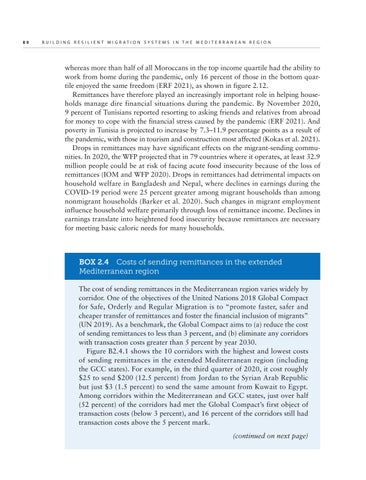80
B U ILDING RESILIENT MIGR A TION S Y STEMS IN T H E MEDITERR A NE A N REGION
whereas more than half of all Moroccans in the top income quartile had the ability to work from home during the pandemic, only 16 percent of those in the bottom quartile enjoyed the same freedom (ERF 2021), as shown in figure 2.12. Remittances have therefore played an increasingly important role in helping households manage dire financial situations during the pandemic. By November 2020, 9 percent of Tunisians reported resorting to asking friends and relatives from abroad for money to cope with the financial stress caused by the pandemic (ERF 2021). And poverty in Tunisia is projected to increase by 7.3–11.9 percentage points as a result of the pandemic, with those in tourism and construction most affected (Kokas et al. 2021). Drops in remittances may have significant effects on the migrant-sending communities. In 2020, the WFP projected that in 79 countries where it operates, at least 32.9 million people could be at risk of facing acute food insecurity because of the loss of remittances (IOM and WFP 2020). Drops in remittances had detrimental impacts on household welfare in Bangladesh and Nepal, where declines in earnings during the COVID-19 period were 25 percent greater among migrant households than among nonmigrant households (Barker et al. 2020). Such changes in migrant employment influence household welfare primarily through loss of remittance income. Declines in earnings translate into heightened food insecurity because remittances are necessary for meeting basic caloric needs for many households.
BOX 2.4 Costs of sending remittances in the extended Mediterranean region The cost of sending remittances in the Mediterranean region varies widely by corridor. One of the objectives of the United Nations 2018 Global Compact for Safe, Orderly and Regular Migration is to “promote faster, safer and cheaper transfer of remittances and foster the financial inclusion of migrants” (UN 2019). As a benchmark, the Global Compact aims to (a) reduce the cost of sending remittances to less than 3 percent, and (b) eliminate any corridors with transaction costs greater than 5 percent by year 2030. Figure B2.4.1 shows the 10 corridors with the highest and lowest costs of sending remittances in the extended Mediterranean region (including the GCC states). For example, in the third quarter of 2020, it cost roughly $25 to send $200 (12.5 percent) from Jordan to the Syrian Arab Republic but just $3 (1.5 percent) to send the same amount from Kuwait to Egypt. Among corridors within the Mediterranean and GCC states, just over half (52 percent) of the corridors had met the Global Compact’s first object of transaction costs (below 3 percent), and 16 percent of the corridors still had transaction costs above the 5 percent mark. (continued on next page)

